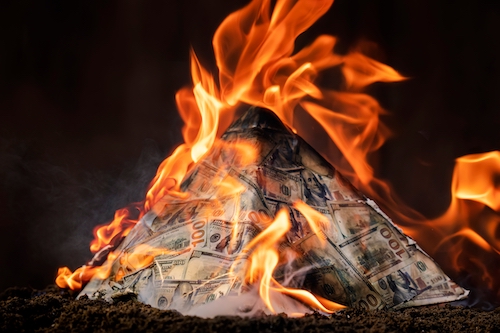BY JIM RICKARDS
A critical hotspot engaging strategic thinkers today is the potential for a Chinese invasion of Taiwan. Of course, China has the world’s largest population, the world’s second-largest economy, and the world’s fourth-largest nuclear arsenal.
As a result, China is at the center of many more complex dynamics than the Taiwan issue. Still, none have as great a potential to expand into a shooting war between great powers (the US, China, Japan, and Australia) than a move by China to invade Taiwan.

Again, some background is a good way to begin the analysis. Following the defeat of Japan in the Second World War and the end of the US occupation of Hopeh and Shantung provinces, the Chinese Communist Party — led by Mao Zedong — and the Nationalist Party — led by Chiang Kai-shek — resumed a civil war for control of China that had begun in late 1928.
By 1949, the Communist Party had taken control of mainland China, while the Nationalist forces retreated to the island of Taiwan and some smaller nearby islands. Both forces declared themselves to be the legitimate government of China, with the Communists proclaiming the People’s Republic of China (PRC) and the Nationalists proclaiming the Republic of China (ROC).
Comparisons of PRC and ROC based on size are slightly misleading, because two-thirds of mainland China is mostly uninhabitable deserts, mountains, and high plateau. Still, there’s no question that mainland China dominates the comparison by size and population. But Taiwan has a significantly higher per capita GDP and has emerged as a technology giant on the global stage.
Who’s in charge?
The US recognised the ROC as the legitimate government of China from 1949–79, at which time the US began full diplomatic relations with the PRC. This change in policy was initiated by Richard Nixon and Henry Kissinger, with Nixon’s historic visit to Beijing and Shanghai in 1972.
The US has nevertheless maintained informal relations with the ROC despite recognition of the PRC using various institutes and NGOs as channels. The US is a major arms supplier to the ROC, although no formal defence treaty exists.
Importantly, China has never considered Taiwan to be a separate country. It’s referred to as a ‘breakaway province’. Any country that offers any diplomatic recognition to Taiwan is punished with severe trade and financial sanctions by China. Lithuania discovered this recently when it allowed Taiwan to open a representative trade office in its capital, Vilnius. Lithuanian exports to China immediately collapsed, as China imposed a near-total trade embargo.
The period from 1949 to today has been an uneasy status quo in which Taiwan has thrived economically, and China has experienced a period of world-historic economic growth, beginning in 1979 and growing exponentially since 1994, under the leadership of Deng Xiaoping and his successors. The two-government fiction was maintained, even as countries around the world moved to recognise the PRC and deal with the ROC informally.
One of the biggest breakthroughs has been the rise of ROC investment in PRC and the integration of the two economies, especially in the areas of high tech and manufacturing. Those who travel from Shanghai to Taipei are familiar with the fact that the flight departs from the ‘domestic’ terminal, not the ‘international’ terminal, because China regards Taiwan as part of one country.
The liberals’ unrealistic expectations of Communist China
This status quo might have continued indefinitely if not for two critical developments: the disillusionment of liberal elites in the West and the rise of Xi Jinping in Communist China.
From the advent of globalisation in 1989 until the global financial crisis of 2008, liberals in the West clung to the idea that economic growth in China would lead to political liberalisation. In a nutshell, liberals believed that with enough time and enough prosperity, China would become ‘just like us’.
This elite plan for the gradual liberalisation of China was the driving force behind the admission of China to the World Trade Organisation in 2001 and the inclusion of the Chinese yuan in the IMF’s world money basket (the SDR) in 2016. China didn’t technically qualify for WTO or SDR status, but it was being ushered into these elite clubs on the view that China would soon conform to what are known as the rules of the game.
This view was amplified by the huge numbers of Chinese students attending elite US universities. The belief was that Chinese students attending Harvard, MIT, and the University of Chicago, among other schools, would return to China, assume leadership roles, and implement polices like those being pushed by elites in the US who had attended the same schools.
This rosy scenario was captured in an excerpt from Foreign Policy on 19 January 2022:
‘After the Cold War, Western elites concluded that realism was no longer relevant and liberal ideals should guide foreign-policy conduct. As the Harvard University professor Stanley Hoffmann told Thomas Friedman of the New York Times in 1993, realism is “utter nonsense today.” US and European officials believed that liberal democracy, open markets, the rule of law, and other liberal values were spreading like wildfire and a global liberal order lay within reach. They assumed, as then-presidential candidate Bill Clinton put it in 1992, that “the cynical calculus of pure power politics” had no place in the modern world and an emerging liberal order would yield many decades of democratic peace. Instead of competing for power and security, the world’s nations would concentrate on getting rich in an increasingly open, harmonious, rules-based liberal order, one shaped and guarded by the benevolent power of the United States.’
Realist observers never put much stock in this view. They insisted that communism was a pervasive ideology, that the Chinese Communist Party maintained rigid control, and that any dissenting views would eventually be wiped out. China would take the economic gains (and intellectual property theft) from interaction with the West but would otherwise stay on the Communist road.
The realist view was always correct, but it took the liberals 30 years to see reality. The awakening of the liberal elite to the reality of Communist China — including slavery, genocide, concentration camps, thought control, arbitrary arrest, and torture — is now in full swing. Detailed policy responses vary, but Democrats and Republicans are united in the view that China is an adversary, if not an outright enemy, and needs to be confronted on both economic and humanitarian grounds.
So make sure you keep this reality in mind when you’re investing…
Regards,
Jim Rickards
Recently Signed Exec Order 14067 Will Be Disaster for Retirement Accounts
Sponsored By: Paradigm Press
On March 9, Biden signed Executive Order 14067, which could pave the way for the new US currency called Biden Bucks. Dems could use this to hold onto power indefinitely. Please view this warning now.
Originally published on DailyReckoning.com



